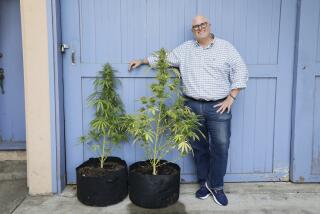The Last Chance to Do Any Serious Planting Until Fall
- Share via
There are always ways to beat the odds, but this weekend should be the last that you do any serious planting until fall. From here on, it is so hot that most plants will wilt as soon as they are put in the ground--odds are that you just can’t keep them wet enough. Of course, watch the Fourth of July be foggy and cold and prove me wrong, ruining that day at the beach and hiding the fireworks.
There are a few exceptions, including bougainvilleas, hibiscus, bananas, gingers and some other subtropicals that can be planted in summer if they are not allowed to go dry, but even these may wilt at first. And, you can always plant in containers--just keep them out of the sun at first.
You might also want to put in a few more plants of leaf lettuce, to go with those tomatoes now ripening, or some other crop that needs replacing, and here is one way to help them out: Buy a bundle of common wood shingles and push one into the soil so it leans over the transplant, giving it temporary shade. Another trick: When sowing seed, plant deeper than normal.
The asparagus knife mentioned in this column several weeks ago, a first-class weeding tool, has eluded some readers, but I suspect it is simply because the people they were asking didn’t know it by that name since it is commonly available. I found mine at a Thrifty drugstore, on sale at that. If you can’t find one, the Rolls-Royce of asparagus knives is available from the mail order catalogue of Walt Nicke (Box 667G, Hudson, N.Y. 12534). It has a sharpened blade and a wooden handle and, according to the catalogue, has been manufactured since 1826. They also call it a “fish tail weeder,” and it sells for $7.95 plus $2.50 shipping.
A thoughtful reader has furnished me with a mail-order source for soil samplers, the best way to find out if you have watered enough, or need to. A. M. Leonard (6665 Spiker Road, Piqua, Ohio 45356; (800) 543-8955) sells the inexpensive one that I have--the Hoffer Soil Sampler, for about $20. This one is in the shape of a T and the 21-inch tube has a section cut away so you can see the core of soil inside.
Bob Galbreath of Drip Irrigation Specialists (6118 West 77th St., Los Angeles 90045) sent me a little plastic sampler for testing the moisture content in a container, so container gardeners don’t need to feel left out of this more precise science. I tried a sample he sent along and it worked well. Push it into the potting soil, twist it, and then pull it out and you can see if it is wet or dry. He sells them for $3, postpaid. He also tells me that the Ben Meadows Co. (2601-B West 5th Ave., Eugene, Ore. 97402; (800) 547-8813) sells six models of soil samplers from $15 to about $55.
And Gary Wilson, who is involved with agricultural irrigation on a grand scale in the San Joaquin Valley, had some interesting comments to add to the column on watering the garden. He notes that the “most common problem I run across in landscape irrigation is too-frequent irrigation events (such as half an hour a day, every day).” I liked the term event. He points out that irrigating every day wastes water because much of it simply sits on the foliage (especially on the blades of grass in a lawn) and then evaporates, something I never thought about.
Mary Delaney Johnston pointed out that I misidentified the caterpillars that nibble on anise. I said they were monarch butterfly larvae, but I really do know better because, when I lived among the anise in Pacific Palisades, I watched many turn into chrysalides and then emerge to become lovely swallowtails, the anise swallowtail to be precise. I even know its scientific name, Papilio zelicaon zelicaon .
I actually planted milkweed once to attract the monarch larvae and succeeded, by growing one of the ornamental milkweeds, Asclepia , or “butterfly weed,” that attract not only larvae to the foliage, but adults to the flowers. I never saw my caterpillars turn into lovely butterflies however, because they emerged just in time to join thousands that were migrating down the coast to Mexico, and got lost in the crowd. My plants were grown from seed ordered from Park Seed (Cokesbury Road, Greenwood, S.C. 29647-0001). Planting either of these “butterfly plants” this weekend would be a satisfying end-of-spring, beginning-of-summer project.






